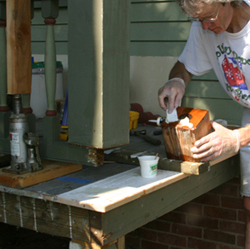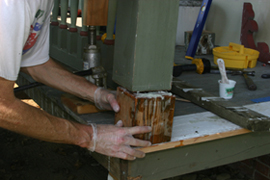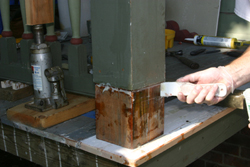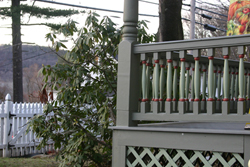Ask the Authority: Porch Floorboards
 Scrap 2x4's and 6 mil poly contain a pool of wood preservative. Each floorboard is allowed to soak for a minute or two in the bath, and then set aside to dry for a day before it gets primed on all surfaces.
Scrap 2x4's and 6 mil poly contain a pool of wood preservative. Each floorboard is allowed to soak for a minute or two in the bath, and then set aside to dry for a day before it gets primed on all surfaces.Q: I need to replace some rotten tongue and groove porch floorboards that were installed only a few years ago. What can I do to ensure that the new ones won't deteriorate just as quickly?
A: The rot organism requires three ingredients in order to reproduce: A food source (wood), warm temperatures, and moisture. Because their ends are directly exposed to the weather, porch floorboards are among the most vulnerable parts of an old house. When your house was built, the original porch flooring was likely milled from a rot-resistant, old growth species such as longleaf heart pine or cypress. Even these hardy materials will succumb to the forces of nature if they're badly neglected; today's fast-growth lumber has very little natural resistance to rot, so it's vital that you completely seal the boards before they're installed.
There are a variety of flooring products on the market synthetic materials as well as chemically-treated wood that claim to be immune to rot. Unfortunately many of them have had serious problems with expansion and contraction when exposed to real world conditions. If you're considering one of these products, please do your research before you buy.
 A bead of caulk prevents water from seeping into the cracks between the floorboards.
A bead of caulk prevents water from seeping into the cracks between the floorboards.When I have to replace floorboards, I use the best quality exterior grade tongue and groove lumber I can find. In the Northeast, where I live now, my local lumberyard stocks vertical grain fir, which is dimensionally stable and somewhat rot-resistant. When ordering material, I make sure the boards are a few inches too long, so I have the option to cut them to length after they're installed.
To make my floorboards as impermeable as possible, I first apply a coating of a clear, paintable wood preservative such as Woodlife Classic (www.wolman.com). Instead of using a brush, I prefer to apply this treatment by soaking the boards in a makeshift dip tank (see Figure A). After soaking for a minute or two in the tank, each board gets set aside to dry for at least 24 hours. The following day, I use a brush to coat all surfaces with a high-quality exterior primer.
 Hammering against a scrap of flooring closes the gaps without marring the floor.
Hammering against a scrap of flooring closes the gaps without marring the floor.Installation is straightforward. I blind-nail the floor boards into the joists by driving 8d galvanized finish nails at a 45 degree angle starting at the back of the tongue; to prevent the tongue from splitting I pre-drill every nail hole. The tongue is particularly vulnerable to rot, especially where water can seep in around the nail holes, so after the nails are set, I run a bead of caulk over the full length of the tongue to provide an extra level of protection (see Figure B & C).
After all of the floorboards are in place, I snap a chalk line, trim the floorboards to length with a circular saw, then fine-tune the cut with a belt sander. While I've got the sander in my hand, I run it across the front edge of the existing flooring to remove the old paint and expose the end grain.
The final step in the process is to ensure that the end grain--new as well as old--is completely sealed; otherwise it will drink up water like a straw. Paint alone provides temporary protection at best. A popular solution to this problem is to glue a piece of half-round molding onto the front edge of the floorboards. This approach is fine as long as the molding doesn't get beaten up by foot traffic.
 Outfitted with a 3/16-in roundover bit, a compact router is used to ease the topside of the flooring. |
 Like a wood preservative on steroids, a two-part epoxy consolidant soaks into vulnerable end grain and cures to form a rock-hard barrier against rot. |
My preferred approach is to round the top edge of the floor (See Figure D) then seal the end grain using an epoxy consolidant from Abatron (www.abatron.com), SystemThree (www.systemthree.com) or one of the other epoxy manufacturers (See Figure E). After the consolidant dries, the end grain takes on a rock-hard consistency that's impervious to moisture, and holds paint very well.
In addition to longevity, the upside of this, admittedly labor-intensive, process is that it makes for a very stable floor (you won't see wide cracks opening and closing due to changes in temperature and humidity). And from a contractor's point-of-view it's not as inefficient as it might seem: Over the years, I've typically had floorboards delivered to my shop well ahead of time. Then if a helper is caught up, or a job gets get rained out, someone can be dipping or priming floorboards during what otherwise would be down time.
 |
Tom O'Brien is a veteran restoration carpenter who writes frequently about construction practices and old houses.
|
